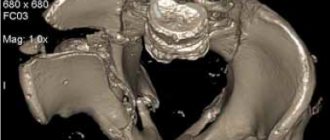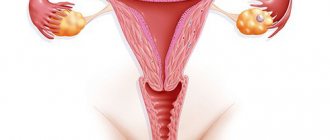Posted by Andro-gynecology clinic at 2018-06-25. Posted on Women, Treatment Methods
The Androgynecological Clinic selects vaginal pessaries and rings for the treatment of prolapse of the uterus and vaginal walls, and urinary incontinence. The article will talk about the conservative treatment of pelvic organ prolapse and stress urinary incontinence, and specifically about the vaginal rings and pessaries of Dr. Arabin (Germany).
Back to contents
What are vaginal pessaries and rings
Vaginal pessaries are devices that are placed in the vagina and prevent prolapse of the uterus and vaginal walls. We wrote in detail about prolapse and prolapse of the vaginal walls and uterine prolapse here.
It should be understood that this method does not lead to a cure, it is a kind of “crutch” that helps a woman alleviate the symptoms of the disease and improve the quality of life. The method is simple, understandable and has been used successfully for a long time. Currently, thanks to modern technologies and hypoallergenic (inert) materials, various forms of pessaries have been created for different forms of pelvic organ prolapse (POP) in women (Figure 1). They are also successfully used for stress urinary incontinence (stress).
Figure 1. Various forms of vaginal pessaries
Back to contents
In what cases are pessaries used?
The need to wear vaginal pessaries and rings arises when the patient has complaints, usually with a moderate degree of pelvic organ prolapse. Most women with initial and moderate degrees of prolapse without complaints do not want to use pessaries, despite the fact that this method is a good prevention of disease progression. There are situations when surgical treatment is impossible for a number of reasons, or the woman herself does not want to undergo surgery. In such a situation, especially in the later stages of the disease, the only effective method of conservative treatment is vaginal pessaries.
Indications for wearing vaginal pessaries
- 2-4 degrees Rectocele (prolapse of the rectum);
- 2-4 degrees Cystocele (prolapse of the bladder);
- 2-4 degree of uterine prolapse;
- Stress incontinence;
- Contraindications to surgical treatment of pelvic organ prolapse and urinary incontinence;
- Woman's refusal to undergo surgery.
Back to contents
NuvaRing vaginal ring 0.015 mg+0.120 mg/day package N1
Registration Certificate Holder
NV ORGANON (Netherlands)
Dosage form
Medicine - NuvaRing®
Description
Vaginal ring
smooth, transparent, colorless or almost colorless, without major visible damage, with a transparent or almost transparent area at the junction.
1 ring
ethinyl estradiol 2.7 mg etonogestrel 11.7 mg
Excipients
: ethylene and vinyl acetate copolymer (28% vinyl acetate) - 1677 mg, ethylene and vinyl acetate copolymer (9% vinyl acetate) - 197 mg, magnesium stearate - 1.7 mg.
1 PC. - waterproof bags made of aluminum foil (1) - cardboard packs. 1 PC. - waterproof bags made of aluminum foil (3) - cardboard packs.
Indications
Contraception.
Contraindications for use
Thrombosis (arterial or venous) and thromboembolism currently or in history (including deep vein thrombosis, pulmonary embolism, myocardial infarction, cerebrovascular disorders);
conditions preceding thrombosis (including transient ischemic attacks, angina) currently or in history; predisposition to the development of venous or arterial thrombosis, including hereditary diseases: resistance to activated protein C, antithrombin III deficiency, protein C deficiency, protein S deficiency, hyperhomocysteinemia and antiphospholipid antibodies (anticardiolipin antibodies, lupus anticoagulant); migraine with focal neurological symptoms currently or in history; diabetes mellitus with vascular damage; pronounced or multiple risk factors for venous or arterial thrombosis: hereditary predisposition to thrombosis (thrombosis, myocardial infarction or cerebrovascular accident at a young age in one of the immediate family), arterial hypertension, lesions of the heart valve apparatus, atrial fibrillation, extensive surgery, prolonged immobilization, extensive trauma, obesity (BMI>30 kg/m2), smoking in women over 35 years of age; pancreatitis (including a history) in combination with severe hypertriglyceridemia; severe liver disease; liver tumors, malignant or benign (including history); established or suspected hormone-dependent malignant tumors (for example, genital organs or breast); vaginal bleeding of unknown etiology; pregnancy (including suspected); breastfeeding period; hypersensitivity to any of the active or excipients. With caution
The presence of risk factors for the development of thrombosis and thromboembolism: hereditary predisposition to thrombosis (thrombosis, myocardial infarction or cerebrovascular accident at a young age in one of the immediate relatives), smoking, obesity, dyslipoproteinemia, arterial hypertension, migraine without focal neurological symptoms, heart valve diseases, heart rhythm disturbances, prolonged immobilization, serious surgical interventions; thrombophlebitis of superficial veins; dyslipoproteinemia; heart valve disease; adequately controlled arterial hypertension; diabetes mellitus without vascular complications; acute or chronic liver dysfunction; jaundice and/or itching caused by cholestasis; cholelithiasis; porphyria; systemic lupus erythematosus; hemolytic-uremic syndrome; Sydenham's chorea (minor chorea); hearing loss due to otosclerosis; angioedema (hereditary) edema; chronic inflammatory bowel diseases (Crohn's disease and ulcerative colitis); sickle cell anemia; chloasma; conditions that make it difficult to use a vaginal ring: cervical prolapse, bladder hernia, rectal hernia, severe chronic constipation.
pharmachologic effect
A combined hormonal contraceptive drug containing etonogestrel and ethinyl estradiol.
Etonogestrel is a progestogen (19-nortestosterone derivative) that binds with high affinity to progesterone receptors in target organs. Ethinyl estradiol is an estrogen and is widely used in the production of contraceptives.
The contraceptive effect is due to a combination of various factors, the most important of which is the suppression of ovulation.
In clinical studies, the Pearl index (an indicator reflecting the incidence of pregnancy in 100 women during 1 year of contraception) in women aged 18 to 40 years was found to be 0.96 (95% CI: 0.64-1.39) and 0.64 (95% CI: 0.35-1.07) in the statistical analysis of all randomized participants (ITT analysis) and the analysis of study participants who completed them according to the protocol (PP analysis), respectively. These values were similar to the Pearl index values obtained in comparative studies of combined oral contraceptives (COCs) containing levonorgestrel/ethinyl estradiol (0.150/0.030 mg) or drospirenone/ethinyl estradiol (3/0.30 mg).
With the use of the drug, the cycle becomes more regular, the pain and intensity of menstrual-like bleeding decreases, which helps reduce the incidence of iron deficiency conditions. There is evidence of a reduced risk of endometrial and ovarian cancer with the use of drugs containing this combination.
Drug interactions
Interaction between hormonal contraceptives
and other drugs may lead to the development of acyclic bleeding and/or contraceptive failure.
Possible interaction with drugs that induce liver microsomal enzymes
, which can lead to increased clearance of sex hormones.
Interactions have been established with the following drugs: phenytoin, barbiturates, primidone, carbamazepine, rifampicin, and possibly also oxcarbazepine, topiramate, felbamate, ritonavir, griseofulvin and preparations containing St. John's wort
.
When treating any of the listed drugs, you should temporarily use a barrier method of contraception (condom) or choose another method of contraception. During concomitant use of drugs that cause the induction of microsomal liver enzymes
, and for 28 days after their cancellation, barrier methods of contraception should be used.
Decreased effectiveness of oral contraceptives containing ethinyl estradiol has been observed with concomitant use of antibiotics such as ampicillin and tetracyclines
.
The mechanism of this effect has not been studied. In a pharmacokinetic interaction study, oral administration of amoxicillin (875 mg twice daily) or doxycycline (200 mg/day followed by 100 mg/day)
for 10 days during drug use had little effect on the pharmacokinetics of etonogestrel and ethinyl estradiol.
When using antibiotics (excluding amoxicillin and doxycycline),
you should use a barrier method of contraception (condom) during treatment and for 7 days after stopping antibiotics. If concomitant therapy is to be continued after 3 weeks of ring use, the next ring should be administered immediately without the usual interval.
Hormonal contraceptives can cause disruption of the metabolism of other drugs. Accordingly, their concentrations in plasma and tissues may increase (for example, cyclosporine) or decrease (for example, lamotrigine).
Dosage regimen
This combination is used as part of a special dosage form for topical use.
Side effect
From the immune system:
hypersensitivity.
Metabolism and nutrition:
increased appetite, weight gain.
From the nervous system:
headache, migraine, dizziness, hypoesthesia, depression, decreased libido, mood changes, fatigue, irritability.
From the urinary system:
cervicitis, cystitis, urinary tract infections, dysuria, urinary urgency, pollakiuria isuria, urinary urgency, pollakiuria.
From the digestive system:
abdominal pain, nausea, bloating, diarrhea, vomiting, constipation.
From the reproductive system:
vaginal infection, engorgement and tenderness of the mammary glands, genital itching in women, painful menstrual-like bleeding, pain in the pelvic area, vaginal discharge, absence of menstrual-like bleeding, discomfort in the mammary glands, enlarged mammary glands, lumps in the mammary glands, cervical polyps uterus, contact (during sexual intercourse) spotting (bleeding), pain during intercourse, ectropion of the cervix, fibrocystic mastopathy, heavy menstrual-like bleeding, acyclic bleeding, discomfort in the pelvic area, premenstrual-like syndrome, burning sensation in the vagina, vaginal odor, pain in the vagina, discomfort and dryness of the vulva and vaginal mucosa.
From the musculoskeletal system:
back pain, muscle spasms, pain in the limbs.
For the skin and skin:
acne, alopecia, eczema, itchy skin, rash, urticaria.
From the side of the organ of vision:
visual impairment.
From the cardiovascular system:
external thromboembolism, hot flashes, increased blood pressure.
Other:
discomfort when using the vaginal ring, loss of the vaginal ring, malaise, swelling, foreign body sensation, difficulty using a contraceptive, rupture (damage) of the ring.
special instructions
If any of the following diseases, conditions or risk factors are present, the benefits and possible risks for each individual woman should be assessed before she starts using the medicine. In case of exacerbation of diseases, deterioration of the condition, or the occurrence of any of the conditions listed below for the first time, a woman should consult a doctor.
The use of hormonal contraceptives may be associated with the development of venous thrombosis (deep vein thrombosis and pulmonary embolism) and arterial thrombosis, as well as associated complications, sometimes fatal.
The use of any COC increases the risk of developing venous thromboembolism (VTE) compared to the risk of VTE in patients not using COCs. The greatest risk of developing VTE is observed in the first year of using COCs. Data from a large prospective cohort study of the safety of various COCs suggest that the greatest increase in risk, compared with the risk in women not using COCs, is observed in the first 6 months after starting COC use or resuming their use after a break (4 weeks or more). . In nonpregnant women not using oral contraceptives, the risk of developing VTE is 1 to 5 per 10,000 woman-years (WY). In women using oral contraceptives, the risk of developing VTE ranges from 3 to 9 cases per 10,000 women. However, the risk increases to a lesser extent than during pregnancy, when it is 5-20 cases per 10,000 YL (pregnancy data are based on the actual duration of pregnancy in standard studies; when converted to a pregnancy duration of 9 months, the risk ranges from 7 to 27 cases per 10,000 JL). In postpartum women, the risk of developing VTE ranges from 40 to 65 cases per 10,000 women. VTE is fatal in 1-2% of cases.
Women using COCs should be advised to consult a doctor if possible symptoms of thrombosis appear. If thrombosis is suspected or confirmed, use of the COC should be discontinued. In this case, it is necessary to use effective contraception, since anticoagulants (coumarins) have a teratogenic effect.
The most important risk factor for developing cervical cancer is infection with the human papillomavirus (HPV). Epidemiological studies have shown that long-term use of COCs leads to an additional increase in this risk, but it remains unclear to what extent this is due to other factors such as more frequent cervical smear examinations and differences in sexual behavior, including. use of barrier contraceptives.
Breast cancer diagnosed in women who use COCs is clinically less severe than cancer diagnosed in women who have never used COCs. The increased risk of breast cancer may be due to the earlier diagnosis of breast cancer in women taking COCs, the biological effects of COCs, or a combination of both.
In rare cases, cases of development of benign, and even more rarely, malignant liver tumors have been observed in women taking COCs. In some cases, these tumors led to the development of life-threatening bleeding into the abdominal cavity. A doctor should consider the possibility of a liver tumor in the differential diagnosis of a woman if symptoms include severe pain in the upper abdomen, an enlarged liver, or signs of intra-abdominal bleeding.
Women with hypertriglyceridemia or a corresponding family history have an increased risk of developing pancreatitis when taking hormonal contraceptives.
Many women taking hormonal contraceptives experience a slight increase in blood pressure, but clinically significant increases in blood pressure are rare. A direct connection between the use of hormonal contraceptives and the development of arterial hypertension has not been established. If a constant increase in blood pressure is observed during use, you should consult your doctor to decide whether to remove the vaginal ring and prescribe antihypertensive therapy. With adequate blood pressure control using antihypertensive drugs, it is possible to resume use of the drug.
During pregnancy and during the use of COCs, the development or worsening of the following conditions was noted, although their relationship with the use of contraceptives has not been definitively established: jaundice and/or itching caused by cholestasis, formation of gallstones, porphyria, systemic lupus erythematosus, hemolytic-uremic syndrome, Sydenham's chorea (minor chorea), herpes of pregnancy, hearing loss due to otosclerosis, angioedema (hereditary) edema.
Acute or chronic liver dysfunction may warrant discontinuation until liver function tests normalize. Recurrence of cholestatic jaundice, previously observed during pregnancy or when using sex steroids, requires discontinuation of the drug.
Women with diabetes should be under constant medical supervision, especially in the first months of contraception.
There is evidence of a worsening of Crohn's disease and ulcerative colitis with the use of hormonal contraceptives.
In rare cases, pigmentation of the facial skin (chloasma) may occur, especially if it occurred earlier during pregnancy. Women predisposed to developing chloasma should avoid exposure to sunlight and ultraviolet radiation.
During use, acyclic bleeding (spotting or sudden bleeding) may occur. If such bleeding is observed after regular cycles with proper use, you should contact your gynecologist to conduct the necessary diagnostic tests, incl. to exclude organic pathology or pregnancy. A diagnostic curettage may be required.
The use of contraceptive hormonal drugs may affect the results of certain laboratory tests, including biochemical indicators of liver, thyroid, adrenal and kidney function, plasma concentrations of transport proteins (for example, corticosteroid binding globulin and sex hormone binding globulin), lipid/lipoprotein fractions, carbohydrate metabolism and indicators of coagulation and fibrinolysis. Indicators, as a rule, vary within normal values.
Use during pregnancy and breastfeeding
Restrictions during pregnancy - Contraindicated. Restrictions when breastfeeding - Contraindicated. Contraindicated during pregnancy and lactation (breastfeeding).
Use for liver dysfunction
Restrictions for liver dysfunction - Contraindicated.
Contraindicated
for severe liver diseases (until normalization of function indicators).
Use in children
Restrictions for children - Contraindicated. The drug is contraindicated for use in children and adolescents under 18 years of age
How pessaries are selected
Various degrees and combinations of forms of prolapse of the walls of the vagina and uterus, as well as the presence or absence of urinary incontinence, require the use of a certain form of this device. Only a specially trained doctor can choose the shape and size. In addition, this requires additional examination to identify contraindications.
Examination before using vaginal pessaries
- Ultrasound examination of the pelvic organs;
- Ultrasound of the bladder and residual urine;
- Flora smear;
- Smear for oncocytology;
- Uroflowmetry - for urinary incontinence;
- Gynecological examination.
At the appointment, the doctor conducts a gynecological examination, determines the shape, degree of prolapse and the approximate size of the adaptation (size) ring, after which he installs it in the patient’s vagina (Fig. 2). Next, it is recommended for the patient with the adaptation ring installed for 15-20 minutes. walk around, climb the stairs, go to the toilet and return for a second examination. If the patient does not experience discomfort and the ring does not fall out of the vagina, this size of adaptation ring is considered suitable. Using a special table, the appropriate size of the pessary of the desired shape is selected, and an explanatory conversation is held about the rules of wearing and use.
Fig 2. Vaginal ring installed
A follow-up appointment is scheduled after 2-4 weeks. It is determined whether the patient uses the pessary correctly, the presence of complaints and the reaction of the vaginal mucosa to a foreign body.
Selection of vaginal pessaries
Back to contents
NuvaRing®
If any of the following conditions/diseases or risk factors are present, a thorough assessment of the benefit-risk ratio of using the drug NuvaRing® should be carried out and discussed with the woman before starting to use the drug. In case of exacerbation of diseases, deterioration of the condition or the appearance of the first symptoms of conditions/diseases or risk factors, the woman should immediately consult a doctor to decide whether to discontinue or the possibility of further use of the drug.
Risk of developing VTE and ATE
The use of any combined hormonal contraceptives (CHCs) is associated with an increased risk of developing venous and arterial thrombosis and thromboembolism (such as DVT and PE, myocardial infarction, cerebrovascular disorders). These diseases are rare. The use of drugs containing levonorgestrel, norgestimate or norethisterone as a progestogen component has the lowest risk of developing VTE.
The use of other medications, such as NuvaRing®, can double the risk of developing this complication. An increased risk is present after initial use of CHCs or resumption of use after a break of 4 weeks or more. The choice in favor of a CHC with a higher risk of developing VTE can only be made after consultation with the woman to ensure that she fully understands the risk of VTE associated with the use of NuvaRing®; the effect of the drug on her existing risk factors and that the risk of developing VTE is greatest in the first year of using the drug.
VTE can be life-threatening or lead to death (in 1-2% of cases).
Thrombosis of other blood vessels, for example, hepatic, mesenteric, renal, cerebral veins and arteries or retinal vessels, has occurred extremely rarely with the use of CGCs.
Symptoms of deep vein thrombosis (DVT):
unilateral swelling of the lower limb or along the vein, pain or discomfort only in an upright position or when walking, local increase in temperature, redness or discoloration of the skin in the affected lower limb.
Symptoms of pulmonary embolism (PE)
: difficulty or rapid breathing; sudden cough, including with hemoptysis; sharp pain in the chest, which may intensify with deep inspiration; sense of anxiety; severe dizziness; fast or irregular heartbeat. Some of these symptoms (eg, shortness of breath, cough) are nonspecific and may be misinterpreted as signs of other more common and less severe conditions (eg, respiratory tract infection).
ATE can lead to stroke, vascular occlusion, or myocardial infarction.
Symptoms of a stroke:
sudden weakness or loss of sensation in the face, limbs, especially on one side of the body, sudden confusion, severe or prolonged headache for no apparent reason, unilateral or bilateral loss of vision; problems with speech and understanding; sudden disturbance in gait, dizziness, loss of balance or coordination; sudden loss of consciousness or fainting with or without a seizure.
Other signs of vascular occlusion
: sudden pain, swelling and slight cyanosis of the extremities, “acute” abdomen.
Symptoms of myocardial infarction:
pain, discomfort, pressure, heaviness, a feeling of compression or fullness in the chest or behind the sternum, radiating to the back, jaw, upper limb, epigastric region; cold sweat, nausea, vomiting or dizziness, severe weakness, anxiety or shortness of breath; fast or irregular heartbeat.
ATE can be life-threatening and lead to death.
In women with a combination of several risk factors or high severity of one of them, the possibility of their mutual reinforcement should be considered. In such cases, the degree of increase in risk may be higher than with a simple summation of factors. In this case, the use of NovaRing® is contraindicated.
The risk of developing thrombosis (venous and/or arterial) and thromboembolism or cerebrovascular disorders increases:
- with age;
- in women who smoke (with an increase in the number of cigarettes or an increase in age, the risk increases, especially over the age of 35);
- if there is a family history (for example, venous or arterial thromboembolism in close relatives or parents under the age of 50 years). In the case of a hereditary or acquired predisposition, the woman should be examined by an appropriate specialist to decide on the possibility of using CHC;
— for obesity (UTI more than 30 kg/m2);
- with dislipoproteinemia;
- for arterial hypertension;
- for migraine;
- for diseases of the heart valves;
- with atrial fibrillation;
- in case of prolonged immobilization, major surgery, any operation on the lower extremities or major trauma. In these cases, the use of CHCs should be discontinued (in the case of planned surgery, at least four weeks before it) and not resumed for two weeks after the end of immobilization. Temporary immobilization (eg, air travel lasting more than 4 hours) may also be a risk factor for the development of VTE, especially in the presence of other risk factors.
The possible role of varicose veins and superficial thrombophlebitis in the development of VTE remains controversial.
The increased risk of thromboembolism in the postpartum period should be taken into account.
Peripheral circulatory disorders may also occur in diabetes mellitus, systemic lupus erythematosus, hemolytic uremic syndrome, chronic inflammatory bowel disease (Crohn's disease or ulcerative colitis) and sickle cell anemia.
An increase in the frequency or severity of migraine (which may also precede cerebrovascular events) during the use of CHCs is grounds for immediate discontinuation of these drugs.
Biochemical indicators indicating a hereditary or acquired predisposition to the development of venous or arterial thrombosis include: resistance to activated protein C, hyperhomocysteinemia, antithrombin III deficiency, protein C deficiency, protein S deficiency, antiphospholipid antibodies (anticardiolipin antibodies, lupus anticoagulant).
The risk of thrombosis and thromboembolism during pregnancy and the postpartum period is higher than when taking low-dose CHCs (containing less than 0.05 mg ethinyl estradiol).
If VTE or ATE is suspected or confirmed, use of the drug should be stopped immediately. In this case, it is necessary to use effective contraception, since anticoagulants (coumarins) have a teratogenic effect.
Risk of developing tumors
The most important risk factor for developing cervical cancer is infection with the human papillomavirus (HPV). Epidemiological studies have shown that long-term use of COCs leads to an additional increase in this risk, but it is unclear how much of this is due to other factors, such as increased frequency of cervical screening and sexual behavior, including the number of sexual partners and less frequent use of barrier contraceptives. and their cause-and-effect relationship. Epidemiological data regarding the incidence of cervical cancer in women using the drug NuvaRing®
There are no data from epidemiological studies regarding the risk of developing cervical cancer in women using the drug NuvaRing®.
A meta-analysis of the results of 54 epidemiological studies found a small increase (1.24) in the relative risk of developing breast cancer in women taking COCs. The risk gradually decreases over 10 years after stopping the drugs. Breast cancer rarely develops in women under 40 years of age, so the additional incidence of breast cancer in women who take or have taken COCs is small compared to the overall risk of developing breast cancer. Women who use COCs are diagnosed with earlier clinical stages of breast cancer than women who have never used COCs. The observed increased risk may be due to earlier diagnosis of breast cancer in women taking COCs, the biological effects of COCs, or a combination of both.
In rare cases, cases of development of benign, and even more rarely, malignant liver tumors have been observed in women taking COCs. In some cases, these tumors led to the development of life-threatening bleeding into the abdominal cavity. The doctor should consider the possibility of a liver tumor in the differential diagnosis of diseases in a woman taking NuvaRing® if symptoms include acute pain in the upper abdomen, liver enlargement, or signs of intra-abdominal bleeding.
Hypersensitivity reactions
Hypersensitivity reactions, such as angioedema and anaphylaxis, have been observed during use of the drug NovaRing®. If you suspect angioedema and/or anaphylaxis, you should stop using the drug NuvaRing® and carry out appropriate treatment.
Hepatitis C
In clinical trials of the drug combination for the treatment of hepatitis C virus ombitasvir/paritaprevir/ritonavir with or without dasabuvir, increases in ALT levels greater than 5 times the upper limit of normal were observed significantly more often in women using drugs containing ethinyl estradiol, such as COOK. The use of NovaRing® should be discontinued before starting therapy with the combination of ombitasvir/paritaprevir/ritonavir with or without dasabuvir (see section “Contraindications” and “Interaction with other drugs”). The use of NuvaRing® can be resumed approximately 2 weeks after completion of treatment with the combination of these drugs.
Other states
- In women with hypertriglyceridemia (or a family history of this condition), the risk of developing pancreatitis may increase while using CHCs.
- Although slight increases in blood pressure (BP) have been described in many women using COCs, clinically significant increases in BP have been reported rarely. However, if a persistent clinically significant increase in blood pressure develops while using the drug NuvaRing®, the use of the drug should be stopped and treatment of arterial hypertension should be started. If normal blood pressure values are achieved with the help of antihypertensive therapy, use of the drug NuvaRing® can be continued.
- The following conditions have been reported to develop or worsen during pregnancy and when taking CHCs, but their relationship with the use of CHCs has not been proven: cholestatic jaundice and/or pruritus associated with cholestasis; formation of gallstones; porphyria; systemic lupus erythematosus; hemolytic-uremic syndrome; chorea; herpes during pregnancy; hearing loss associated with otosclerosis. Cases of Crohn's disease and ulcerative colitis have also been described with the use of CHCs.
— In women with hereditary forms of angioedema, exogenous estrogens may cause or worsen symptoms of angioedema.
— Acute or chronic liver diseases may require discontinuation of the drug NuvaRing® until liver function tests return to normal.
— Recurrence of cholestatic jaundice and/or itching caused by cholestasis, which first developed during pregnancy or previous use of sex hormones, requires discontinuation of the drug NuvaRing®.
- Although estrogens and progestogens can affect insulin resistance and glucose tolerance, in patients with diabetes mellitus using low-dose CHCs, as a rule, no dose adjustment of hypoglycemic drugs is required. However, patients with diabetes mellitus should be carefully monitored while using NuvaRing®.
- Chloasma can sometimes develop, especially in women with a history of chloasma during pregnancy. Women with a tendency to chloasma should avoid prolonged exposure to the sun and ultraviolet irradiation while using NuvaRing®.
— Conditions of a woman in which she will not be able to insert the ring correctly or in which the ring may fall out: cervical prolapse, bladder hernia and/or rectal hernia, severe chronic constipation.
— In very rare cases, women have unintentionally inserted the NuvaRing® vaginal ring into the urethra and possibly into the bladder. When symptoms of cystitis appear, it is necessary to consider the possibility of incorrect insertion of the ring.
— Cases of vaginitis have been described during the use of the drug NuvaRing®. There are no clinical data regarding the effect of vaginitis therapy on the effectiveness of the use of the drug NovaRing®, as well as the effect of the use of the drug NovaRing® on the effectiveness of therapy for vaginitis.
— Very rare cases of a ring sticking to the vaginal mucosa have been described, requiring its removal by a medical professional. In some cases where tissue had grown around the ring, removal was accomplished by cutting the ring without cutting the vaginal tissue.
Medical examination/consultation
Before prescribing the drug NuvaRing® or resuming its use, you should carefully review the woman’s medical history (including family history) and conduct a gynecological examination to exclude pregnancy. It is necessary to measure blood pressure, conduct an examination of the mammary glands, pelvic organs, including a cytological examination of cervical smears and some laboratory tests, to exclude contraindications and reduce the risk of possible side effects of the drug. The frequency and nature of medical examinations depend on the individual characteristics of each patient. but medical examinations are carried out at least once every 6 months. A woman should read the instructions for use and follow all recommendations. The woman should be informed that NuvaRing® does not protect against HIV infection (AIDS) and other sexually transmitted diseases.
Reduced efficiency
The effectiveness of the drug NovaRing® may decrease if the regimen is not followed (see the subsection “Deviations from the recommended regimen” of the section “Dosage and Administration”) or concomitant therapy is carried out that reduces the concentration of etonogestrel in the blood plasma (see section “Interaction with other drugs” ).
Changes in the nature of menstruation
During use of the drug NovaRing®, acyclic bleeding may occur (“spotting” spotting or sudden bleeding). If such bleeding is observed after regular cycles with the correct use of the drug NuvaRing®, you should contact your gynecologist to conduct the necessary diagnostic studies, including to exclude organic pathology or pregnancy. A diagnostic curettage may be required.
Some women do not bleed after the ring is removed. If the drug NuvaRing® was used according to the instructions, it is unlikely that the woman is pregnant. If the recommendations of the instructions are not followed and there is no bleeding after removing the ring, as well as if there is no bleeding for two cycles in a row, pregnancy must be excluded.
Effects of ethinyl estradiol and etonogestrel on a sexual partner
The possible pharmacological effects and extent of exposure of ethinyl estradiol and etonogestrel to male sexual partners (due to absorption through penile tissue) have not been studied.
Ring damage
In rare cases, when using the drug NuvaRing®, ring rupture was observed. The core of the drug NuvaRing® is solid, so its contents remain intact, and the release of hormones does not change significantly. Vaginal injury associated with ring rupture has been reported. If the ring ruptures, it usually falls out of the vagina (see the recommendations in the subsection “What to do if the ring has been temporarily removed from the vagina” in the “Dosage and Administration” section). If the ring ruptures, a new ring must be inserted.
Ring falling out
Sometimes the NuvaRing® vaginal ring may fall out of the vagina, for example, if it is inserted incorrectly, when a tampon is removed, during sexual intercourse, or due to severe or chronic constipation. In this regard, it is advisable for a woman to regularly check the presence of the NuvaRing® vaginal ring in the vagina (for example, before and after sexual intercourse). If the NuvaRing® vaginal ring falls out of the vagina, you must follow the recommendations of the subsection “What to do if the ring has been temporarily removed from the vagina” in the “Method of administration and dosage” section.
Rules for using vaginal pessaries
Vaginal rings can be left in the vagina for up to 5-6 days; cubic and mushroom-shaped pessaries cannot be worn for more than 24 hours; they are removed daily before bed! If a woman does not need the ring while sleeping, it is also removed. After removal, the pessary should be washed under warm running water and soap and dried. It should be stored in a plastic container or bag.
The pessary is inserted in the morning in a standing position with a raised leg or squatting, this is described in detail in the video above. To facilitate insertion, you can use a hygienic gel.
Back to contents
Other conservative treatments for pelvic organ prolapse
When a diagnosis of pelvic organ prolapse is made, it is recommended to carry out protective measures aimed at reducing increased intra-abdominal pressure.
Preventive actions
- Lifestyle changes and weight loss;
- Reducing the intensity of physical activity (limiting heavy lifting);
- Change of occupation - transfer to light work;
- Prevention of constipation and respiratory diseases accompanied by a chronic increase in abdominal pressure.
Exercises to strengthen the pelvic floor muscles
In the initial stages of prolapse of the vaginal walls, it is possible to perform exercises to strengthen the pelvic floor muscles (Kegel exercises). These exercises are effective only in the early stages of the disease when the muscles of the pelvic floor and the tendon center of the perineum are preserved. If the pelvic floor muscles are incompetent, these exercises will only do harm - they will lead to the progression of pelvic organ prolapse.
Physiotherapy
There are various methods of influencing physical factors (laser, magnetic field) on the vaginal walls and underlying tissues. This method can lead to a reduction in the degree of prolapse by improving tissue nutrition - increasing the tone of the pelvic floor. The use of physical factors is effective in the early stages of the disease, when there are still no complaints and the diagnosis is made only upon examination in a chair.
Physiotherapy is widely used as a recovery stage after surgical treatment and in the prevention of the development of prolapse in the postpartum period.
Volume-forming methods based on hyaluronic acid
The method is used to treat urinary incontinence in the early stages of the disease. It consists of creating additional support for the urethra during stress urinary incontinence through tissue tension by creating additional volume. The effect is temporary, from 6 to 8 months. for hyaluronic acid fillers, up to a year or more for lipofilling.
Injections and fillers of hyaluronic acid are used to treat degenerative processes in the tissues of the perineum and pelvic floor; the effect is very pronounced but also temporary.
All of these methods are prescribed when a diagnosis has been established, after a preliminary examination, because they have contraindications. The most pronounced effect can be achieved by combining these techniques, taking into account contraindications to each of them. It is not possible to do this on your own! We recommend that all women at risk undergo a specialized consultation with a gynecologist at the Androgynecological Clinic to identify pelvic organ prolapse
Back to contents
Pros of a vaginal ring (contraceptive ring and birth control ring)
The undoubted advantage of the new method is the form of “taking” the contraceptive. You don’t have to remember every day to take a pill, you don’t have to carry the package with you in your purse all the time, you don’t have to time your intake, worry about being several hours late, or panic about missing a pill. In addition, with this method of protection, hormones do not pass through the stomach and liver, which reduces the possibility of action on the entire body. Accordingly, some side effects, such as nausea and headache, are reduced to a minimum. In addition, the contraceptive effect is not reduced if a woman suddenly starts vomiting or has an upset stomach. There are no calluses or chafing due to the ring in the vagina. A correctly inserted ring will not fall out, and you can easily play sports, swim, or go to the bathhouse with it. Very rarely, when having sex, men notice the presence of a ring in the vagina. And many of those who still feel it there say that it does not bother them at all, and sometimes even additionally pleasantly stimulates them.
Cons of a vaginal ring
All the negative aspects of the vaginal ring are also associated with the form of “taking” the contraceptive. After all, a ring is a foreign body placed in the vagina for 21 days. The vaginal mucosa tries to reject it, and, as a result, inflammation develops. Based on this, this method of contraception is not recommended for women with chronic inflammatory diseases of the pelvic organs. Some women experience worsening chronic infectious diseases, such as cystitis, thrush or gardnerellosis. In addition, the vaginal ring, like combined oral contraceptives, can cause weight gain and swelling, as fluid retention occurs in the body under the influence of hormones. Others are simply uncomfortable living with “something” inside the vagina, feeling it, and constantly being afraid that it will fall out unnoticed during sex or going to the toilet.
Contraindications for the contraceptive ring
The contraceptive ring is not suitable for: • cervical erosion, • inflammation in the uterus, vagina or ovaries, • problems with the genitourinary system: since it can provoke an exacerbation of chronic diseases - cystitis, thrush, • migraines with focal neurological symptoms, • if you smoke and over 35 years of age, • if you are over 35 years of age and have quit smoking less than a year ago, • if you are very overweight, • if you are taking certain medications, • if your vaginal muscles cannot hold the vaginal ring due to prolapse of the vaginal walls or weakness of the vaginal muscles, • thrombosis (blood thickening) of any vein or artery, • heart abnormalities or vascular disease, including hypertension (high blood pressure), • angina or stroke, • systemic lupus erythematosus, • current breast cancer, or within the last five years, • acute diseases of the gallbladder or liver, • diabetes with complications (angiopathy), • vaginal bleeding of unknown cause, • pregnancy or suspicion of it, • lactation period. There remains a risk of developing side effects characteristic of all combined pills: it can cause weight gain, engorgement of the mammary glands, spotting during the cycle. Some of these side effects go away after 2-3 months of use, but sometimes women refuse the ring right away because of them.
Who is the vaginal ring recommended for ? Thus, like any other hormonal contraceptive drug, the vaginal ring has a number of advantages and disadvantages. Therefore, before you start using the Nova Ring vaginal ring, you should consult a gynecologist and undergo the necessary examination. It is indicated for those women who have a regular partner, do not have any chronic infectious diseases of the genitourinary system and everything is fine with the cervix.
Attention! The hormonal vaginal ring does not protect against sexually transmitted diseases. Therefore, a prerequisite for its use is the presence of one permanent sexual partner, and the absence of sexually transmitted infections in both of you.
When to start using the Nova Ring
If you have not used hormonal contraceptives before, then the hormonal ring is administered between the 1st and 5th day of the menstrual cycle, but no later than the 5th day, even if the menstrual bleeding has not stopped. In the first 7 days of the first cycle, additional contraception with barrier methods is required. If you are switching to a ring from another hormonal method of contraception, check with your doctor exactly when you need to start using the contraceptive ring.
Risk group for the development of uterine and vaginal prolapse
Women who have aggravating factors that contribute to the development of POP are at risk.
Risk factors
- Childbirth with a large fetus, traumatic birth, rapid labor, multiple pregnancies, multiparous women;
- Hard physical work, sports;
- Sedentary lifestyle and work (doctors, teachers, office workers, etc.);
- Connective tissue dysplasia;
- Obesity;
- Chronic constipation and cough (chronic bronchitis, smoking);
- Age over 45 years - hypoestrogenism and associated dystrophic changes in the tissues of the pelvic floor and lower parts of the genitourinary system.
READ SUMMARY
Consultation and treatment of women with pelvic organ prolapse in our clinic is carried out by a regional representative of the Pelvioperinatology Center (St. Petersburg):








